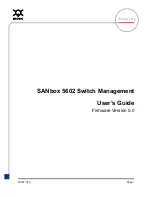
IDT sRIO Ports
Revision 1.5
Integrated Device Technology, Inc.
CPS-16/12/8 User Manual
2 - 5
July 10, 2012
Figure 2.2 Illustration of the Trace Function within a Given Port
From an application perspective, the support for comparison over the first 160 bits of the packet is to ensure
that the trace function can cover the worst case RapidIO header (including those using extended
addressing) plus the first 32 bits of the payload. This implementation is totally flexible across the first 160
bits of the packet and ensures that the following parameters can be used as trace criteria: 1) the header’s
ftype field (4 bits), 2) the header’s destination ID field (8 or 16 bits), 3) the header’s mbox field (up to 8 bits),
4) the first 32 bits of the packet payload (32 bits). Note that If the input port detects an error in the received
packet it will not be routed to the trace port.
2.2.2 Trace Output Port Features
At any given time the device supports a single Trace-enabled output port. It can be dynamically defined
which output port is enabled for the Trace function. All packets which match the Trace Criteria from all trace
enabled inputs is routed to the same configured trace output port.
The device supports the ability for the port defined as the output trace port to be also part of a multicast
group. At the same time it is also possible for the user to configure the trace output port to match the
intended destination port of a packet.
2.2.3 Trace Routing Features
CPS routing function in support of the trace function is provided in two modes.
The trace port needs to be disable first before changing to a new trace port.
0
159
RIO Packet Received
at Port n of 16
First 160 bits of packet
0
159
Programmable Comparison 0
Mask 0
Mask 1
Programmable Comparison 1
Mask 2
Mask 3
Programmable Comparison 2
Programmable Comparison 3
Trigger
0
159
0
159
0
159
0
159
0
159
0
159
0
159
















































